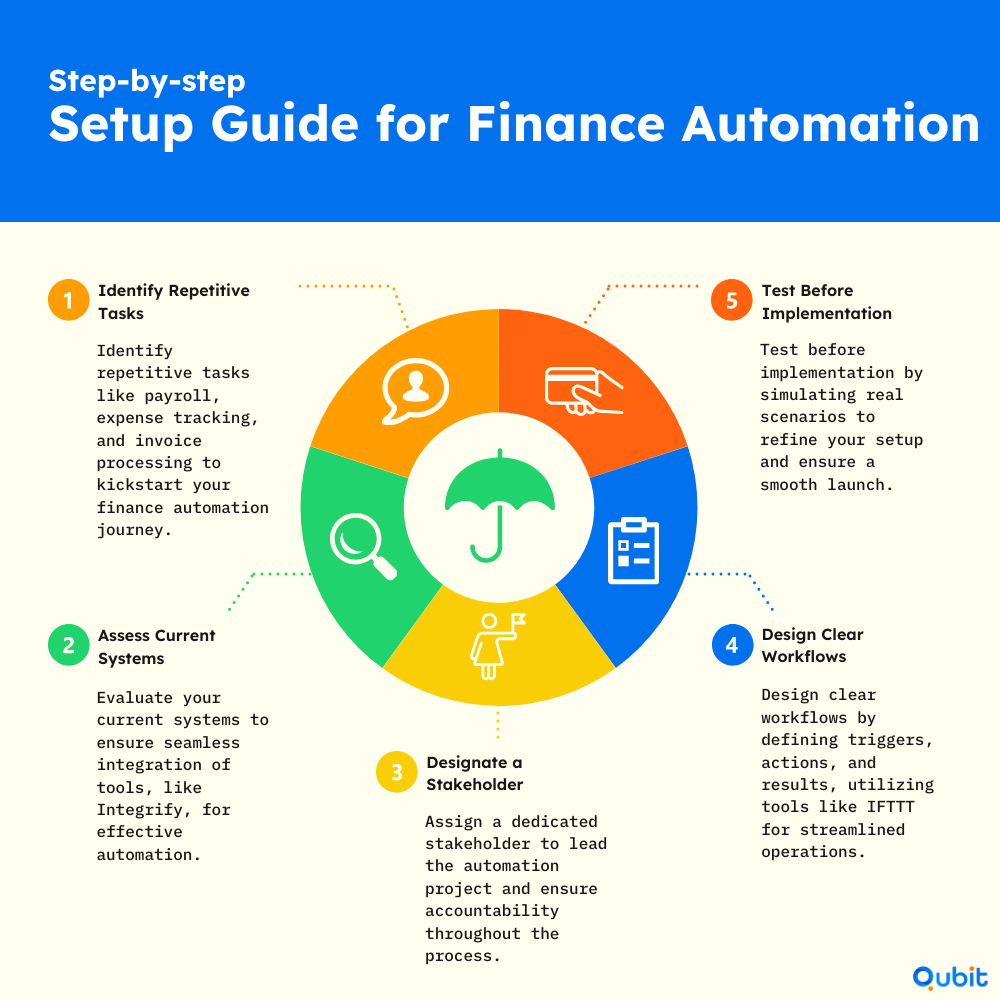Time-consuming financial tasks can drain resources and lead to costly mistakes. Automating financial processes offers a solution by streamlining operations and minimizing human error. From payroll to expense tracking, automated financial tools simplify complex workflows, allowing businesses to focus on growth. Finance automation not only reduces manual effort but also enhances accuracy, ensuring reliable data for decision-making.
To ensure your financial models are investor-ready, it's essential to focus on building robust financial projections. This foundation is critical for attracting investors and maintaining trust in your financial operations.
This article explores actionable strategies for automating finance, highlighting how businesses can save time and reduce errors while improving efficiency.
Understanding Finance Automation
Finance automation is reshaping the way businesses handle their financial processes. By incorporating artificial intelligence (AI), robotic process automation (RPA), and predefined workflows, organizations can digitize traditionally manual tasks, such as accounting and financial reporting. This transformation reduces human intervention while ensuring consistent quality and accuracy in operations.
Automated financial systems streamline operations by eliminating repetitive tasks, such as invoice processing and reconciliation. AI-powered tools analyze data faster and more accurately than traditional methods, enabling businesses to make informed decisions in real time. Predefined workflows further enhance efficiency, ensuring tasks are completed systematically without delays.
The benefits of finance automation extend beyond operational efficiency. It empowers businesses to allocate resources strategically, focus on innovation, and reduce costs associated with manual errors. As the finance sector continues to evolve, automation is becoming a cornerstone of modern financial management.
Key Financial Processes to Automate
Streamlining financial operations is essential for businesses aiming to improve efficiency and accuracy. Automating key financial processes can significantly reduce manual errors, save time, and prepare organizations for evolving global challenges. Below are the financial functions that are ideal candidates for automation.
Accounts Receivable
Automating Accounts Receivable processes simplifies recurring invoices and overdue payment reminders. This ensures consistent cash flow and reduces the administrative burden of tracking payments manually.
Payroll
Payroll automation brings uniformity to employee payment schedules. By eliminating manual calculations, businesses can ensure timely and accurate compensation while maintaining compliance with labor laws.
Purchase Order Solutions
Digital purchase order systems replace outdated spreadsheet reconciliation methods. These tools streamline procurement workflows, making it easier to manage vendor relationships and track expenses.
Reporting and Analysis
Real-time reporting consolidates key performance indicators (KPIs) into actionable insights. Automated systems enhance data analysis, enabling businesses to make informed decisions quickly.
Accounts Payable
Automating Accounts Payable processes ensures invoices are managed efficiently and paid on time. This reduces the risk of late fees and strengthens vendor relationships.
Tax Solutions
Tax automation utilizes scanning technologies to simplify compliance. By digitizing tax-related documentation, businesses can reduce errors and meet regulatory requirements with ease.
Preparing for Global Changes
As regulations and market conditions shift, automation becomes critical for sustainability. Businesses must adopt flexible systems that can adapt to new compliance standards and global economic trends.
Selecting the best financial forecasting software can significantly enhance your automation efforts by offering precision and scalability. These tools not only streamline forecasting but also integrate seamlessly with other automated financial services.
Automation is no longer a luxury—it’s a necessity for businesses aiming to stay competitive in a fast-changing environment.
Step-by-Step Guide to Setting Up Finance Automation
Streamlining financial operations through automation can save time, reduce errors, and improve efficiency. This guide walks you through the essential steps to implement financial process automation effectively.

1. Identify Repetitive Tasks
Begin by pinpointing tasks that are repetitive and require minimal human intervention. Ideal candidates for automation include invoice processing, expense tracking, and payroll management. Tools like Zapier can help streamline these tasks by connecting existing apps and automating workflows.
2. Evaluate Your Current Systems
Assess your current technological infrastructure to ensure compatibility with finance automation tools. For example, platforms like Integrify facilitate seamless integration between digital systems, making it easier to automate processes without overhauling existing software.
3. Assign a Dedicated Stakeholder
Designate a stakeholder to oversee the automation project. This person will be responsible for coordinating between teams, monitoring progress, and ensuring that the automation aligns with organizational goals. Having a dedicated point of contact minimizes confusion and keeps the project on track.
4. Design Clear Workflows
Create workflows that clearly define triggers, actions, and outcomes. For instance, using IFTTT can simplify routine tasks by setting specific triggers, such as sending a notification when a payment is processed. Documenting these workflows ensures clarity and consistency across the team.
5. Test Before Implementation
Rigorous testing is crucial to avoid errors and disruptions. Simulate real-world scenarios to identify potential issues and refine workflows. Testing ensures that the automation functions as intended before full-scale deployment.
To further enhance your understanding of automated processes, explore advanced financial modeling techniques. These techniques complement automation by providing deeper insights into financial data and decision-making.
Finance automation tools like Zapier, IFTTT, and Integrify are invaluable for streamlining operations, but success hinges on careful planning and execution.
Unlocking the Benefits of Finance Automation
Finance automation is changing the game for organizations. By automating repetitive tasks, you boost efficiency and accuracy. This shift frees up time and resources, letting your team focus on strategic work.
- Increased Accuracy:
Automated systems cut down on human error. Manual data entry can lead to costly mistakes. Automation makes data handling precise and consistent. - Streamlined Workflows:
With rule-based automation, financial operations become smoother. Consistent, error-free processes help maintain compliance and reduce discrepancies.
Automation also supports smarter decision-making. For example, knowing how to perform scenario analysis is a game-changer. By integrating automated scenario analysis into your financial model, you can:
- Identify key performance indicators.
- Adjust assumptions based on market trends.
- Build multiple scenarios—best-case, worst-case, and most likely.
- Compare outcomes quickly to pinpoint risks and opportunities.
This hands-on approach ensures that your forecasts stay robust and adaptable. With accurate data tracking and actionable insights, finance automation not only improves reporting but also lays the groundwork for predictive analytics.
Challenges of Finance Automation
Automating financial processes can streamline operations, but it also brings challenges that need careful management.
- Compliance Risks:
- Automation errors may breach regulatory requirements and attract penalties.
- Poorly designed systems can disrupt IT infrastructure, causing costly downtime.
- Human Factor Concerns:
- Over-reliance on automation can hurt employee morale if seen as a threat to job security.
- Inaccuracies in automated systems might lead to flawed reporting, damaging reputation and trust.
Mitigating these risks requires robust change management strategies. Clear communication about automation enhancing human contributions is essential. Regular monitoring helps catch errors quickly, ensuring compliance and smooth operations while minimizing disruptions.
For businesses looking to integrate advanced tools, AI financial modeling tools can automate complex calculations and provide predictive insights, reducing manual effort. These tools offer a practical example of how automation can enhance financial workflows without compromising accuracy or compliance.
Limitations of Early Automation Efforts
The initial wave of automated financial services primarily revolved around expanding ERP systems and implementing basic robotic process automation (RPA). While these solutions provided some efficiency gains, they were often rigid and struggled to adapt to evolving business needs. ERP systems, for instance, required extensive customization to fit unique workflows, leading to high implementation costs and prolonged timelines.
Early RPA implementations, though promising, revealed significant shortcomings. These tools were designed to handle repetitive tasks but lacked the flexibility to accommodate dynamic finance workflow automation. Additionally, their reliance on static scripts meant frequent updates and maintenance, which drained resources and hindered scalability.
The challenges faced in automating record-to-report processes underscored the need for more agile and comprehensive solutions. Incorporating advanced techniques for financial models is a natural next step in automating financial processes.
Achieving Operational Efficiency Through Automation
Manual finance processes often lead to delays, errors, and inefficiencies. Automation eliminates repetitive tasks like manual data entry and creates dynamic digital workflows. This leads to more accurate financial reporting and smoother operations.
- Streamlined Processes:
- Month-end closes become faster with automated workflows.
- Real-time dashboards simplify KPI tracking and reporting.
Digital systems let finance teams focus on analyzing insights instead of compiling data. This shift paves the way for more strategic decision-making.
Automation also frees up leaders to concentrate on high-value initiatives. With fewer operational bottlenecks, they can drive growth, refine forecasts, and align financial strategies with broader goals.
Today, finance automation is essential for staying competitive. It unlocks efficiency and empowers teams to focus on strategic innovation and long-term success.
Conclusion
Streamlining financial processes is no longer a luxury—it’s a necessity for businesses aiming to thrive in competitive markets. By implementing automation strategies, organizations can significantly reduce errors, improve efficiency, and free up valuable time for strategic decision-making. From adopting advanced software solutions to integrating AI-driven tools, the actionable steps discussed in this article provide a clear roadmap for enhancing financial operations.
The benefits of automation extend beyond operational improvements. Businesses gain the ability to focus on growth initiatives, strengthen investor relationships, and make data-driven decisions with confidence. Speaking of investors, let us help. We will connect you with the right investors and drive strategic growth.
Take the first step toward smarter financial management today—partner with experts who understand your goals and can help you achieve them.
Key Takeaways
- Finance automation leverages AI and RPA to digitize tasks efficiently.
- Critical processes such as Accounts Receivable, Payroll, and Reporting are ideal for automation.
- A systematic setup and thorough testing are essential to reduce errors.
- Automation increases data accuracy, consistency, and strategic focus.
- Managing risks proactively is key to successful automation implementation.
Frequently asked Questions
How do automated financial processes improve efficiency in startups?
Automated financial processes enhance efficiency by minimizing manual tasks such as data entry, which significantly reduces error rates. These systems provide real-time reporting, allowing startups to make quicker, data-driven decisions. By streamlining routine operations, startups can allocate resources to focus on innovation and scaling. Key advantages include faster processing times, improved accuracy in financial reporting, and reduced risks associated with human error.


 Back
Back



